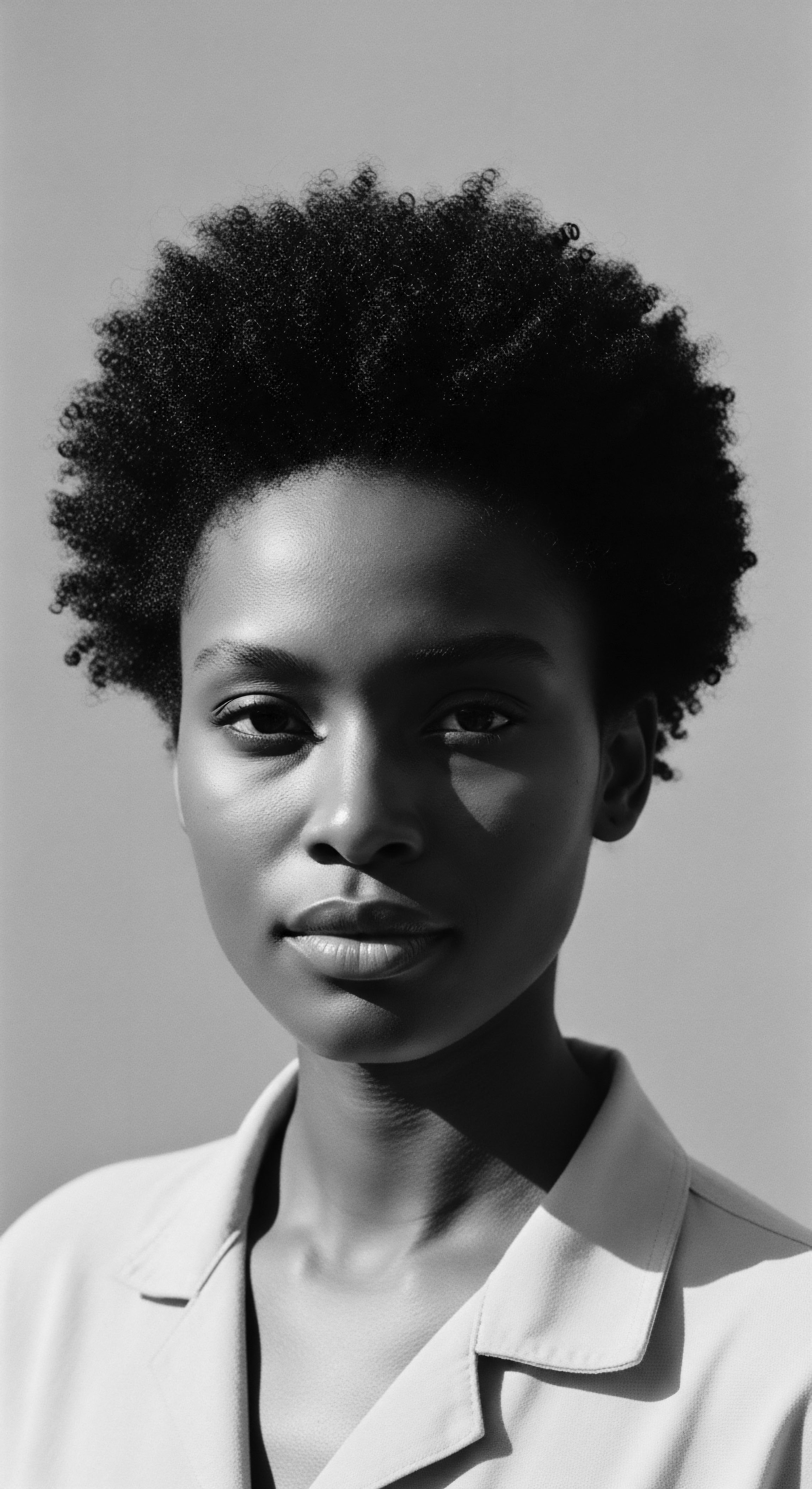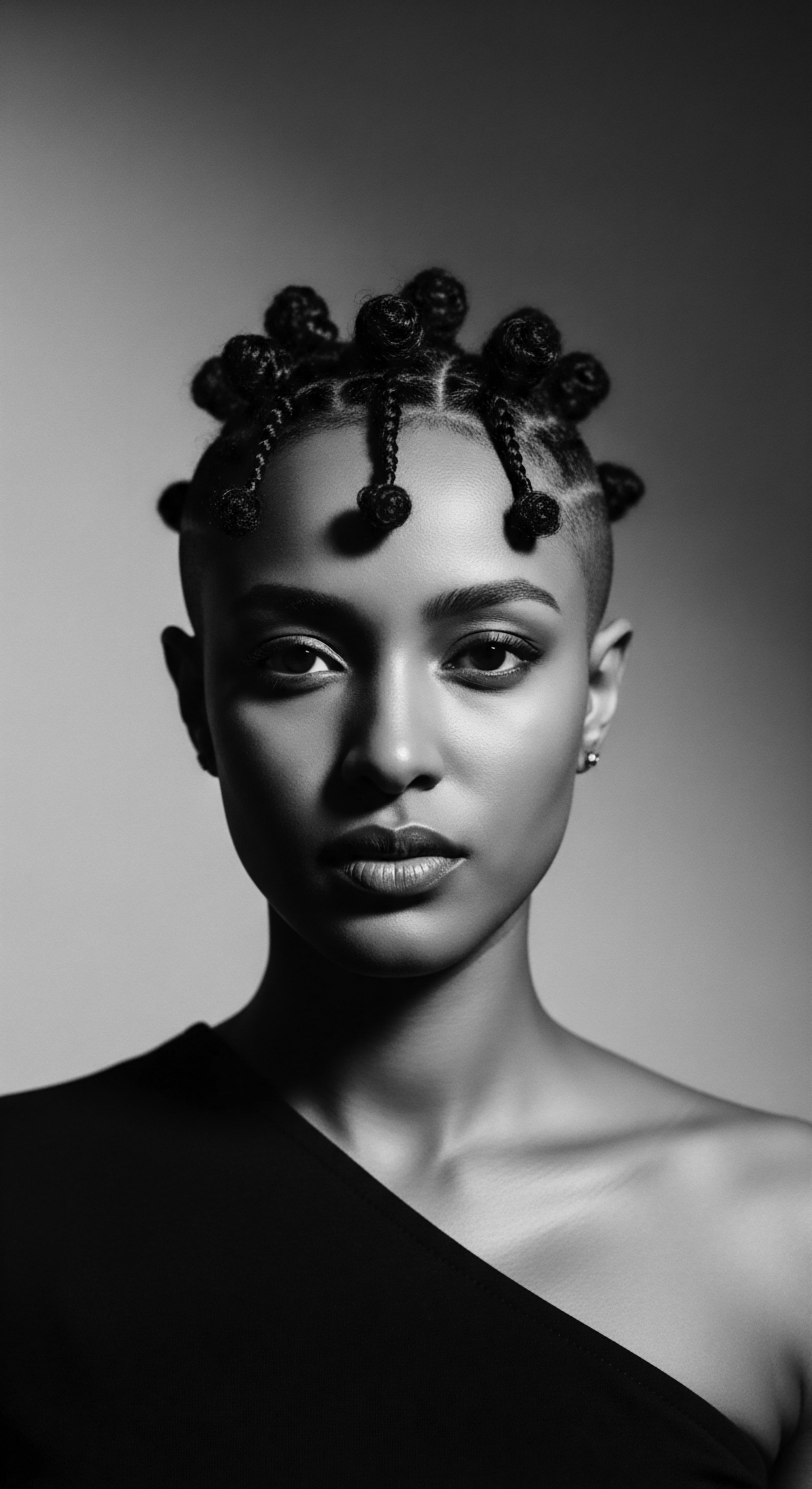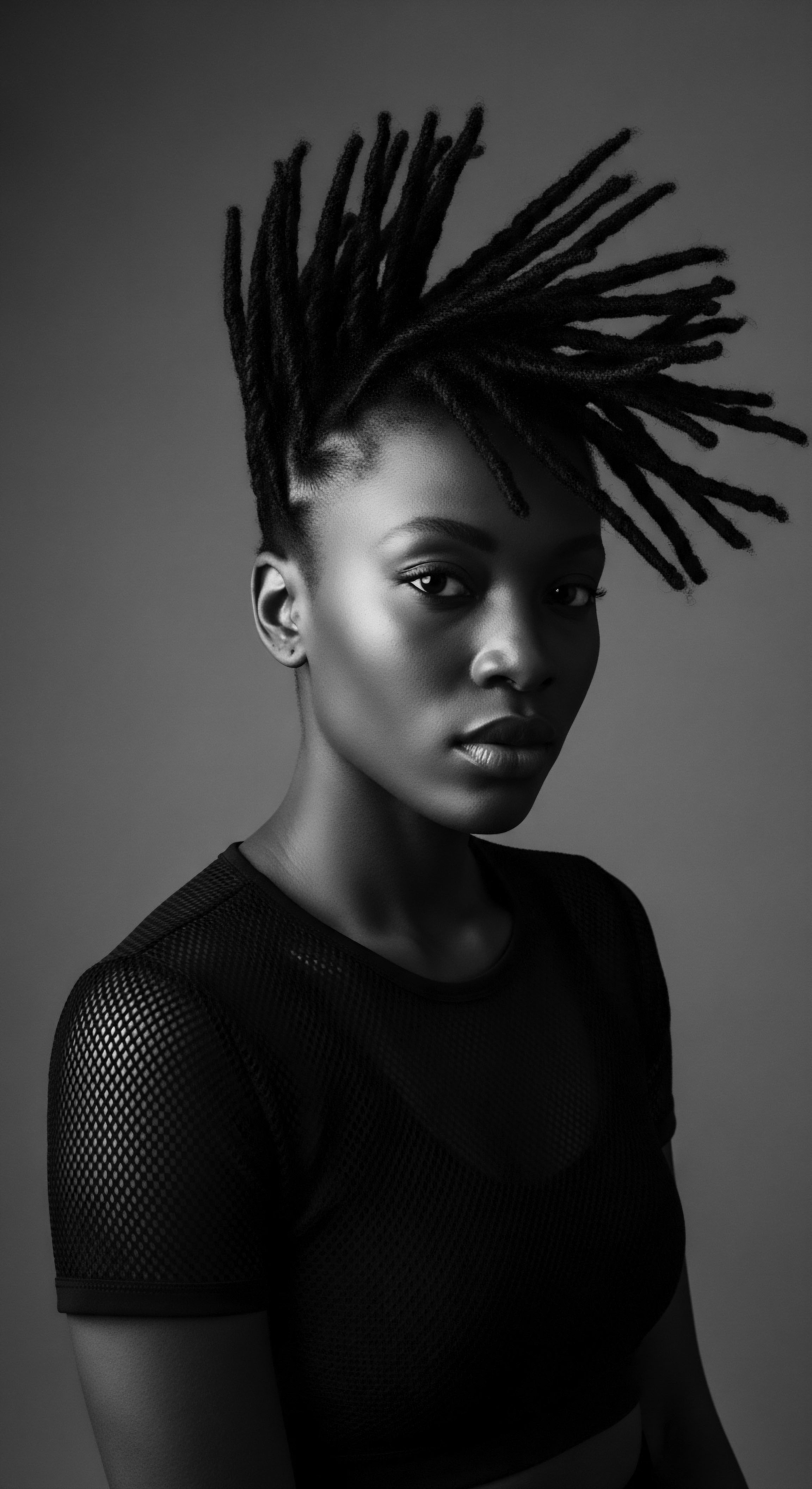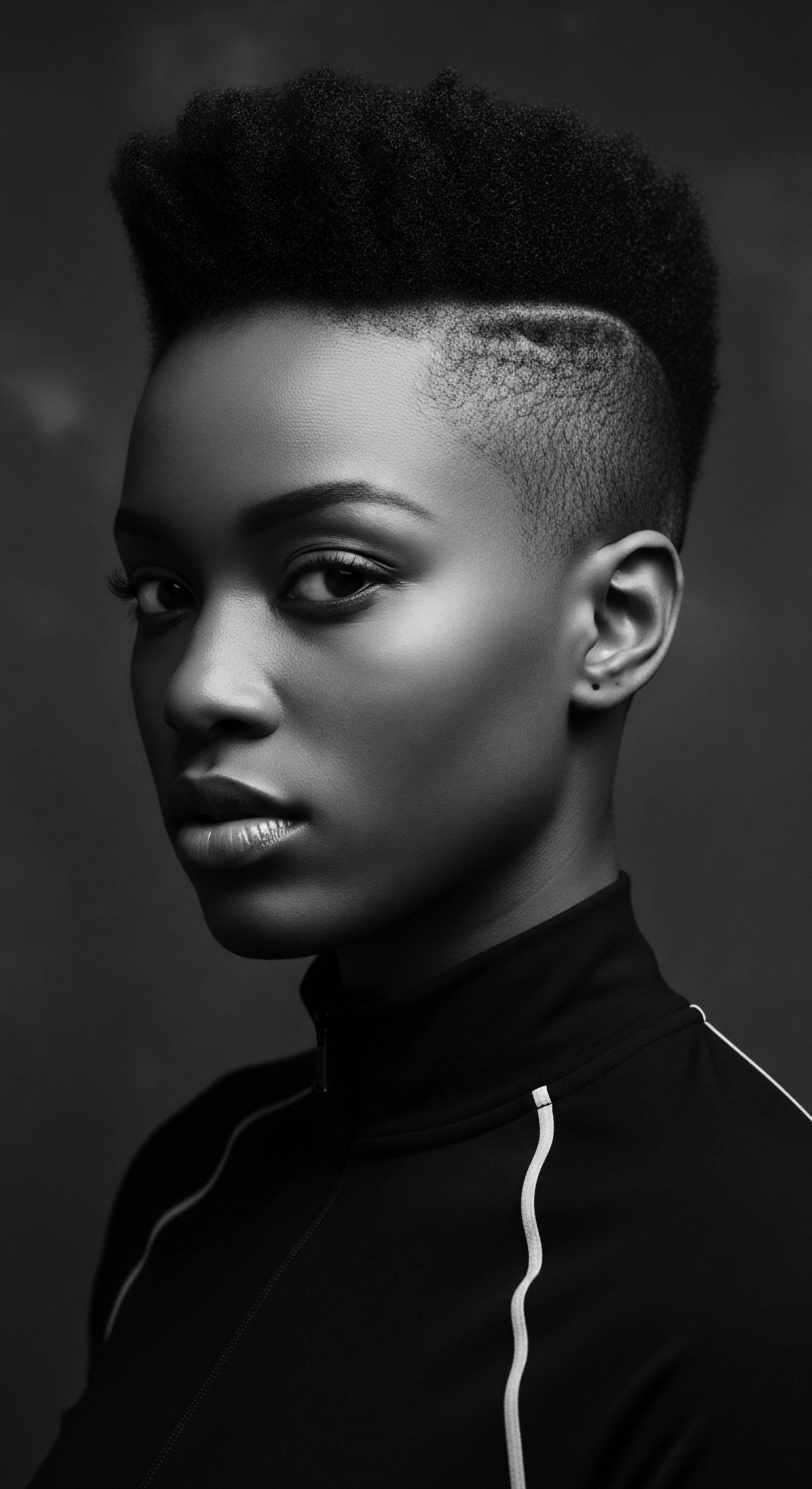
Fundamentals
The Rastafari Hair Culture, at its very core, represents a profound reclamation of identity, a deliberate and tangible expression of spirit, heritage, and defiance. To genuinely grasp its depth, one must look beyond the surface appearance of matted strands and consider the vibrant intellectual and spiritual tradition from which it springs. This distinctive hair practice, often referred to as dreadlocks, or simply ‘locks,’ stands as a sentinel, guarding ancestral memories and speaking volumes about self-determination for Black and mixed-race communities across the globe.
At its earliest inception, the cultivation of locks within the Rastafari livity (way of life) was not a mere fashion choice. It emerged in Jamaica during the 1930s, a period of intense social upheaval and colonial subjugation. The practice served as a visible rejection of European aesthetic norms, which had long dictated that straight, smooth hair was the standard of beauty and respectability.
Those pioneering Rastafari brethren, drawing inspiration from biblical texts (such as the Nazarite vow in Numbers 6) and African warrior traditions, allowed their natural hair to grow untamed, forming ropes of coiled hair that became a stark counterpoint to the chemically straightened or closely cut styles prevalent in the colonial landscape. This particular manifestation, the physical unkempt nature of the hair, took on an elemental meaning; it was a return to an authentic, unadulterated state of being.
The Rastafari Hair Culture, through the purposeful cultivation of locks, serves as a powerful testament to the reclamation of Black identity and a rejection of colonial beauty standards.

Early Manifestations ❉ A Sacred Styling
The earliest adherents of Rastafari recognized the profound connection between personal presentation and spiritual conviction. Their choice to cultivate locks was a conscious departure from the imposed ideals of beauty and an assertion of an African-centered worldview. The term ‘dreadlocks’ itself carries a double layer of significance; while often used by outsiders to denote fear or something ‘dreadful,’ within the community, it signified a reverence for their commitment to Jah (God) and a profound respect for their lineage. These coiled strands were, and remain, a physical manifestation of a spiritual covenant, a vow to live in accordance with divine law and ancestral principles.
The formation of these locks was organic, sometimes beginning without specific methods beyond allowing hair to naturally knot and tangle. This process allowed the hair to dictate its own path, mirroring the Rastafari aspiration for a life guided by natural order and divine will.
- Lion of Judah Symbolism ❉ The flowing mane of the Lion of Judah, a central symbol in Rastafari, found a tangible parallel in the cascading locks, connecting wearers to the imperial majesty of Emperor Haile Selassie I, who is regarded as the living God.
- Nazarite Vow ❉ Adherence to biblical passages, particularly the Nazarite vow, underscored the spiritual discipline of allowing hair to grow freely, refraining from cutting or combing, as a sign of dedication and separation for divine purpose.
- Rejection of Babylon ❉ The decision to keep locks was a visible rejection of ‘Babylon,’ the corrupt oppressive system of the Western world, and its associated beauty standards and practices.

Symbolism at Its Heart ❉ The Rooted Crown
The meaning behind the Rastafari Hair Culture runs deep, intertwining spiritual conviction with historical memory. Each coil and twist of a lock represents a journey, a strand of personal history woven into a collective narrative of endurance and sovereignty. For adherents, the head is the temple of Jah, and the hair, a living crown, is never to be defiled by razors or chemicals. This particular understanding of hair as sacred, as an extension of one’s spiritual being, connects the Rastafari Hair Culture to ancient African traditions where hair often held significant cosmological and social meanings.
The length and density of one’s locks can, for some, reflect the passage of time, the accumulation of spiritual strength, and the steadfastness of their faith. These are not merely individual preferences; they are markers of a collective identity, visible statements of belonging to a faith that champions righteousness, repatriation, and resistance. The locks also serve as a source of strength, akin to Samson’s legendary power in biblical accounts, reinforcing a sense of resilience and divine protection in a world often hostile to their beliefs.

Intermediate
Moving beyond the foundational understanding, the Rastafari Hair Culture unfolds as a complex phenomenon, its meaning and practice deepening with each generation. The hair, in its distinct forms of locks, becomes a dynamic canvas upon which the ideologies of Rastafari are etched, making visible the invisible tenets of their spiritual and social philosophy. This isn’t simply a matter of personal choice; it is a profound declaration, a living manifesto against the long shadows of colonial oppression and a vibrant affirmation of Black liberation. The locks, therefore, embody a form of visual rhetoric, continually articulating the community’s stand on social justice, environmental stewardship, and spiritual integrity.
The intermediate consideration of Rastafari hair moves past its origins to its propagation and cultural impact. The adoption of locks spread beyond the strict confines of early Rastafari communities, influencing Black cultural movements globally. The sight of locks became synonymous with defiance, authenticity, and an unapologetic celebration of African heritage.
This association was further cemented by the rise of Reggae music, whose global reach carried the visual imagery and spiritual messages of Rastafari to every corner of the earth. Musicians like Bob Marley, with his iconic mane, transformed locks from a misunderstood fringe practice into a powerful symbol of conscious resistance, artistic expression, and cultural pride.

The Cultural Assertion ❉ Reclaiming the Textured Helix
The journey of the Rastafari Hair Culture is intrinsically linked to the broader story of textured hair. For centuries, across the African diaspora, indigenous hair textures were subjected to erasure, deemed ‘unprofessional’ or ‘unruly’ by dominant Eurocentric beauty standards. The very act of allowing African hair to grow in its natural state, to coil and matt into locks, was a revolutionary rejection of this systemic subjugation. This conscious decision recognized the inherent dignity and beauty of hair as it naturally grows from the scalp, mirroring the earth’s own organic processes and rhythms.
The coils and kinks, often demonized, were instead celebrated as a reflection of divine creation and ancestral connection. This movement was, in essence, a profound re-education, not just for the wearer, but for observers, challenging preconceived notions of beauty and order.
The decision to cultivate locks represented a reclaiming of agency over one’s body and image. It was a refusal to conform to a system that sought to devalue Black bodies and cultural expressions. The locks, therefore, became a visible sign of self-love and self-acceptance, encouraging others within the Black diaspora to reconsider their own relationships with their natural hair. This phenomenon contributed significantly to the burgeoning natural hair movement of the mid to late 20th century, providing a tangible example of how African hair could be worn with pride and reverence.
Rastafari locks serve as a powerful emblem of defiance against colonial beauty standards, affirming the inherent beauty and dignity of textured hair and inspiring global Black liberation movements.

Practices of Sustenance ❉ The Tender Thread of Care
The maintenance of Rastafari locks, while often perceived as hands-off, involves a meticulous and respectful approach to hair care rooted in natural principles. The goal is not just to maintain appearances, but to sustain the health and integrity of the locks as they grow, embodying a holistic wellness perspective. This traditional care often involves minimal manipulation, avoiding harsh chemicals, and utilizing natural ingredients. The belief that the hair is an antenna, connecting the individual to divine energy, reinforces the need for purity in its treatment.
Traditional Rastafari hair care rituals often involve specific practices that honor the organic process of locing while maintaining scalp health.
- Water Cleansing ❉ Regular cleansing, often with only water or mild, natural soaps, prioritizes purity and allows the hair to interlock without residue. This echoes ancient practices of minimal product use and reverence for natural elements.
- Herbal Infusions ❉ The application of herbal infusions, such as aloe vera, rosemary, or neem, nourishes the scalp and hair. These ingredients, drawn from the natural world, connect the physical act of care to ancestral botanical knowledge.
- Minimal Manipulation ❉ The avoidance of excessive combing or brushing allows the hair to naturally coil and matt. This practice respects the hair’s organic growth pattern and prevents breakage, aligning with a philosophy of non-interference.
- Protective Styles ❉ For those with longer locks, wrapping them in turbans or cloths, particularly when engaged in labor or outdoor activities, protects them from environmental elements and reinforces their sacred status.
The communal aspect of hair care can also be important within Rastafari, with individuals assisting each other in the maintenance of their locks, creating bonds of fellowship and mutual support. This shared experience deepens the cultural significance of the practice, transforming a personal routine into a communal ritual that reinforces the collective identity. This intergenerational sharing of knowledge concerning natural hair care methods stands as a testament to an enduring heritage of self-sufficiency and communal well-being.
| External Perception ("Babylon") Symbol of deviance, criminality, and unruliness, often associated with a lack of hygiene. |
| Rastafari Interpretation (Livity) Emblem of purity, spiritual commitment, and the Nazarite vow, representing a covenant with Jah. |
| External Perception ("Babylon") Obstacle to employment and social acceptance, marking individuals for discrimination. |
| Rastafari Interpretation (Livity) Badge of honor, distinguishing true believers and rejecting the oppressive system of Babylon, asserting economic independence through alternative means. |
| External Perception ("Babylon") A primitive or 'backward' aesthetic, in direct opposition to European beauty standards. |
| Rastafari Interpretation (Livity) An ancestral crown, connecting wearers to ancient African royalty, biblical heritage, and a natural, unadulterated state of being. |
| External Perception ("Babylon") A style to be suppressed or forcibly altered, especially in institutional settings like schools and prisons. |
| Rastafari Interpretation (Livity) A sacred, untouchable aspect of one's being, a source of strength and spiritual power, demanding respect and autonomy. |
| External Perception ("Babylon") The profound chasm between external judgment and internal meaning highlights the Rastafari Hair Culture's powerful role in identity formation and resistance. |

Academic
The Rastafari Hair Culture, viewed through an academic lens, transcends simple aesthetic choice; it presents as a complex socio-spiritual phenomenon, a living ethnography of resistance, identity formation, and decolonization embedded within the very fiber of the Black body. This particular hair practice, far from being a static tradition, has undergone dynamic interpretations and adaptations, reflecting both internal theological developments and external socio-political pressures. The theoretical implications of locks extend into fields such as cultural anthropology, postcolonial studies, sociology of religion, and critical race theory, offering a rich terrain for scholarly inquiry into power, representation, and subaltern agency.
At its most rigorous academic meaning, the Rastafari Hair Culture is a performative act of defiance, a somatic symbol of an anti-colonial epistemology. It represents a conscious refusal to participate in the epistemic violence of Eurocentric beauty norms, which historically sought to denigrate African physical characteristics as a means of social control and psychological subjugation. The act of allowing one’s textured hair to naturally lock, without chemical intervention or frequent combing, becomes a deeply subversive gesture, challenging the very foundations of racial hierarchy and aesthetic capitalism.
This is a powerful demonstration of what scholar Stuart Hall terms ‘cultural resistance,’ where marginalized groups create their own alternative symbolic systems to assert their value and contest dominant narratives. The unkempt, naturally growing hair, then, becomes a site of contestation, a visible marker of a counter-hegemonic worldview.

Genealogies of Identity ❉ The Embodied Philosophy
The Rastafari Hair Culture draws its conceptual strength from a rich genealogy of Black identity and resistance. Its formation is not a haphazard evolution but a deliberate cultivation rooted in specific historical moments and cultural aspirations. The physical appearance of locks, particularly in the mid-20th century, was a direct aesthetic challenge to the ‘colonial aesthetic,’ a term describing the pervasive influence of European standards on self-perception and societal worth within colonized nations. This colonial aesthetic demanded adherence to straight hair, lighter skin, and European features as benchmarks for success and acceptance, effectively forcing a rejection of indigenous Black physiognomy.
In the face of this, early Rastafari adherents consciously adopted locks as a symbol of their inherent dignity and African heritage, reclaiming an identity often suppressed or demonized. This practice resonated deeply with the principles of Pan-Africanism, which sought to unify and uplift people of African descent globally. The locks became a visible link to ancient African cultures, where coiled and intricate hairstyles often conveyed social status, tribal affiliation, and spiritual connection.
The very structure of Afro-textured hair, with its unique coiling pattern, lends itself to locking, making the practice an organic and inherent expression of its biological potential. The deliberate choice to let this natural process occur, rather than fight it with hot combs or chemical relaxers, was a powerful act of self-acceptance and decolonization of the mind and body.
Academic interpretation reveals the Rastafari Hair Culture as a dynamic socio-spiritual phenomenon, a performative act of defiance against colonial epistemologies, and a profound assertion of Black agency and identity.

The Embodied Philosophy ❉ Resistance in Every Strand
The Rastafari Hair Culture functions as a profound embodied philosophy, a material expression of resistance against systemic oppression. It is within this context that we can examine specific historical instances of the struggle for recognition and autonomy. Consider the case of the Coral Gardens Incident in Jamaica in April 1963, a brutal crackdown by the Jamaican state against Rastafari adherents. While the violence was widespread, encompassing killings and arbitrary arrests, a particular dimension involved the forcible shaving of Rastafari men’s heads by authorities.
This act, documented by multiple historical accounts including Barry Chevannes’ seminal work, “Rastafari and Other African-Caribbean Worldviews” (1995), was not merely a measure of humiliation; it was a targeted assault on the very symbol of Rastafari identity and spiritual integrity. The systematic stripping of their locks by the police and military underscored the state’s attempt to de-legitimize and dehumanize the Rastafari movement, revealing the deep-seated fear and contempt that the dominant society held for this emergent Black consciousness. The government’s deliberate attack on their hair, their sacred ‘crown,’ highlights the extent to which Rastafari hair was perceived as a direct threat to the established order, a visible rejection of conformity and a powerful assertion of autonomous selfhood (Chevannes, 1995).
This historical example profoundly illuminates the Rastafari Hair Culture’s connection to textured hair heritage and Black experiences. It demonstrates that the choice to wear locks was not simply a religious custom; it was an act of political defiance that invited severe repercussions. The state’s response, through the forced shaving, acknowledged the locks’ potent symbolic value as a marker of an alternative, unyielding identity. This specific incident underscores how the hair became a battleground, a site where the struggle for Black self-determination was physically enacted.
The legacy of Coral Gardens serves as a poignant reminder that for many Black and mixed-race individuals, their hair, particularly in its natural, untamed state, has historically been, and sometimes continues to be, a site of profound vulnerability and tenacious resistance. This legacy further solidifies the perception of locks as a symbol of unwavering commitment to one’s heritage, despite external pressures.
| Ritual Element Refusal to Cut/Comb |
| Significance in Rastafari Livity A literal adherence to the Nazarite vow, symbolizing a permanent dedication to Jah and an unbroken connection to divine energy. Each strand holds spiritual memory. |
| Connection to Ancestral Practices Echoes certain African spiritual traditions where hair was considered an extension of the soul or a conduit for spiritual energy, never to be severed without sacred reason. |
| Ritual Element Washing with Natural Substances |
| Significance in Rastafari Livity Purity of the temple (head), avoiding chemicals deemed unnatural or 'Babylonian.' Promotes physical and spiritual cleanliness. |
| Connection to Ancestral Practices Aligns with widespread ancestral African uses of plant-based cleansers, clays, and oils for hygiene and ritual purification, emphasizing harmony with nature. |
| Ritual Element Protective Wrapping (e.g. turbans) |
| Significance in Rastafari Livity Safeguarding the sacred crown from defilement or pollutants, both physical and spiritual. Also a sign of reverence and distinction. |
| Connection to Ancestral Practices Mirrors historical practices in numerous African cultures where headwraps, turbans, and elaborate coverings protected and adorned hair, signifying status, spiritual devotion, or marital state. |
| Ritual Element Communal Loc Maintenance |
| Significance in Rastafari Livity Strengthening community bonds through shared care and mutual respect. A physical manifestation of collective unity and support within the brethren. |
| Connection to Ancestral Practices Reflects communal grooming practices prevalent in many traditional African societies, where hair styling was a social event, fostering intergenerational knowledge transfer and strengthening kinship ties. |
| Ritual Element These practices illuminate how the Rastafari Hair Culture is a living archive, preserving ancestral wisdom and adapting it to a contemporary spiritual path. |

Global Reverberations ❉ The Unbound Helix
The influence of Rastafari Hair Culture has expanded far beyond its Jamaican origins, contributing significantly to a global discourse on Black aesthetics, religious freedom, and human rights. Locks have ceased to be solely a Rastafari marker; they have been adopted by diverse individuals seeking to connect with African heritage, express individuality, or simply embrace their natural hair texture. This widespread adoption has, paradoxically, led to both greater acceptance and continued battles against discrimination in various institutional settings. The legal and social challenges faced by Rastafari in the mid-20th century continue to inform modern-day hair discrimination lawsuits, particularly concerning policies that disproportionately affect individuals with Afro-textured hair.
The ongoing struggle for legislative protections, such as the CROWN Act in the United States, stands as a testament to the enduring impact of Rastafari’s pioneering stance. These legal frameworks aim to prohibit discrimination based on hair texture and protective hairstyles, including locks, acknowledging the historical prejudices embedded in workplace and school policies. The journey of the Rastafari Hair Culture thus provides a compelling historical precedent for the broader movement to validate and celebrate Black hair in all its natural forms. It acts as a powerful reminder that the fight for hair freedom is intimately tied to the larger struggle for racial justice and self-determination, recognizing that the freedom to wear one’s hair naturally is a fundamental human right.
The deep meaning of Rastafari hair lies in its dynamic interplay between individual spiritual commitment and collective cultural identity. The explication of its significance, therefore, requires a multi-layered analysis that accounts for its theological roots, its historical agency in anti-colonial movements, and its contemporary relevance as a global symbol of natural beauty and resistance. The designation of locks as a sacred form transforms hair from a biological byproduct into a potent cultural artifact, imbued with generations of meaning and profound social resonance.
Furthermore, understanding this culture provides important insights into the psychology of self-perception and external validation within diasporic communities. For many, wearing locks is a daily affirmation of self-worth and a conscious act of detaching from standards that do not reflect their true selves. This internal shift, from seeking external approval to cultivating inner strength, is a significant aspect of the Rastafari spiritual journey, and the hair stands as its most visible testament. The connection to ancestral practices, therefore, is not merely symbolic; it is a lived reality, a continuum of care and expression passed down through generations, affirming the enduring power of heritage.

Reflection on the Heritage of Rastafari Hair Culture
As we contemplate the rich tapestry woven by the Rastafari Hair Culture, a profound recognition arises ❉ this is far more than a style; it is a living, breathing archive of heritage, resistance, and spiritual devotion. Each strand of a lock, meticulously formed by time and intention, carries the echoes of countless generations who understood hair not as a mere adornment, but as a sacred conduit. It speaks to the resilience of textured hair, often subjected to erasure and denigration, yet perpetually finding ways to assert its beauty and intrinsic value. The Rastafari journey reminds us that the quest for self-definition often begins with reclaiming what is inherently ours—our bodies, our traditions, and the very crowns that grow from our heads.
The enduring legacy of the Rastafari Hair Culture calls upon us to view our own hair, particularly textured hair, with reverence and understanding. It encourages a deeper inquiry into the historical narratives embedded within our coils and kinks, prompting a soulful connection to the ancestral wisdom that guided generations before us. In this exploration, we discover that the true care of our hair extends beyond superficial treatments; it encompasses a holistic embrace of our heritage, a celebration of our natural forms, and a recognition of the profound spiritual significance that has always resided within the hair of Black and mixed-race communities. The Rastafari Hair Culture stands as a timeless beacon, illuminating the pathway to self-acceptance and a profound connection to the Soul of a Strand.

References
- Chevannes, Barry. Rastafari and Other African-Caribbean Worldviews. Palgrave Macmillan, 1995.
- Barrett, Leonard E. The Rastafarians ❉ The Word and the Flesh. Beacon Press, 1976.
- Campbell, Horace. Rastafari ❉ The Evolution of a Philosophy. Africa World Press, 2017.
- Cashmore, Ernest. The Rastafarians. Minority Rights Group, 1979.
- Homiak, John P. “The ‘Anointed For Life’ Elders of the Rastafari” in The Jamaican Historical Review, Vol. 20. 2000.
- Nicholas, Tracy. Rastafari ❉ A Way of Life. International Research & Education for Development, 2014.
